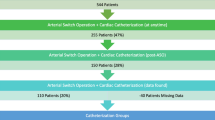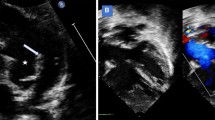Summary
A review of 59 anatomical specimens and of the findings in 65 surgically repaired patients with atrioventricular septal defect (AVSD), revealed four patients with a single papillary muscle and 11 with a double-orifice left ventricle. A single papillary muscle of the left ventricle occurred in 1.7% (1 of 59) of the anatomical specimens, and 6% (4 of 65) of the surgical cases. A double orifice of the left ventricle was found in 13.6% (8 of 59) of the anatomical specimens, and 7.7% (6 of 65) of the surgical cases. A single papillary muscle was only seen in cases with a complete defect. Double orifice was associated with partial, complete, or intermediate type of defect, with the highest incidence in the intermediate forms: 40% (4 of 10) of the anatomical specimens and 22% (2 of 9) of the surgical cases.
In the anatomical study the specimens, with either single papillary muscle or double-orifice left ventricle, appear to be variants of the same malformation characterized by convergence of chordal insertion and underdevelopment of the left lateral leaflet. Pathology belonging to this spectrum was seen in 15% of our autopsy specimens and 14% of the surgical cases. In the surgical series good operative results were obtained with a conservative approach in cases with a favorable surgical anatomy.
Similar content being viewed by others
References
Bharati S, Lev M, McAllister HA Jr, Kirklin JW (1980) Surgical anatomy of the atrioventricular valve in the intermediate type of common atrioventricular orifice.J Thorac Cardiovasc Surg 79:884–889
Carpentier A (1978) Surgical anatomy and management of a mitral component of atrioventricular canal defects. In: Anderson RH, Shinebourne EA (eds)Paediatric cardiology 1977. Churchill Livingstone, Edinburgh, pp 477–486
David I, Castaneda AR, van Praagh R (1982) Potentially parachute mitral valve in common atrioventricular canal.J Thorac Cardiovasc Surg 84:178–186
Greenfield WS (1976) Double mitral valve.Trans Pathol Soc Lond 27:128–129
Ilbawi MN, Idriss FS, DcLeon SY, Riggs TW, Muster AJ, Berry TE, Paul MH (1983) Unusual mitral valve abnormalities complicating surgical repair of endocardial cushion defects.J Thorac Cardiovasc Surg 85:697–704
Lie C-N, Danielson G, Schaff H, Puga F, Mair D (1985) Surgical treatment of double orifice mitral valve in atrioventricular canal defects.J Thorac Cardiovasc Surg 90:700–705
Piccoli GP, Yen Ho S, Wilkonson JL, McCartney FJ, Gerlis LM, Anderson RH (1982) Left-sided obstructive lesions in atrioventricular septal defect. An antomic study.J Thorac Casrdiovasc Surg 83:453–460
Reed GE, Luis EC, Claus RH (1970) The surgical repair of the mitral orifice.Ann Thorac Surg 9:81–84
Schiebler GL, Edwards JE, Burchell HB, DuShane JW, Ongley PA, Wood EH (1961) Congenital corrected transposition of the great vessels. A study of 33 cases. Pediatrics 27 (suppl):850–888
Shone JD, Sellers RD, Anderson RC, Adams PJ, Lillehei CW, Edwards JE (1963) The developmental complex of “parachute mitral valve” supravalvular ring of left atrium, subaortic stenosis and coarctation of the aorta.Am J Cardiol 11:714–725
Ugarte M, Enriquez de Salamanca F, Quero M (1976) Endocardial cushion defects. An anatomical study of 54 specimens.Br Heart J 38:674–682
Wakai CS, Edwards JE (1958) Pathologic study of persistent common atrioventricular canal,Am Heart J 56:779–794
Warnes C, Somerville J (1983) Double mitral valve orifice in atrioventricular defects.Br Heart J 49:59–64
Wigle ED (1957) Duplication of the mitral valve.Br Heart J 19:296–300
Author information
Authors and Affiliations
Rights and permissions
About this article
Cite this article
Yvonne Draulans-Noë, H.A., Wenink, A.C.G. & Quaegebeur, J. Single papillary muscle (“Parachute valve”) and double-orifice left ventricle in atrioventricular septal defect convergence of chordal attachment: Surgical anatomy and results of surgery. Pediatr Cardiol 11, 29–35 (1990). https://doi.org/10.1007/BF02239544
Issue Date:
DOI: https://doi.org/10.1007/BF02239544




